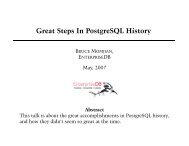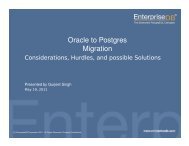Using PostgreSQL for Flight Planning - PGCon
Using PostgreSQL for Flight Planning - PGCon
Using PostgreSQL for Flight Planning - PGCon
You also want an ePaper? Increase the reach of your titles
YUMPU automatically turns print PDFs into web optimized ePapers that Google loves.
<strong>Using</strong> <strong>PostgreSQL</strong> <strong>for</strong><br />
<strong>Flight</strong> <strong>Planning</strong><br />
Blake Crosby<br />
<strong>PGCon</strong> 2011
Agenda<br />
Introduction<br />
Tools<br />
Math Class<br />
Everything you need to know about the Earth<br />
Ground School<br />
Challenges<br />
Displaying the data<br />
Q&A Session<br />
2<br />
<strong>Using</strong> <strong>PostgreSQL</strong> <strong>for</strong> <strong>Flight</strong> <strong>Planning</strong><br />
20/05/2011
Some Introductions…<br />
<br />
<br />
<br />
Senior System Administrator<br />
Keep cbc.ca up and running<br />
Manage Apache+Tomcat &<br />
Postgres servers.<br />
<br />
<br />
<br />
PHP Programmer<br />
Pilot (~250 hours)<br />
Co-Founder of World <strong>Flight</strong><br />
Planner<br />
facebook.com/blakecrosby<br />
fly.blakecrosby.com<br />
@blakecrosby<br />
me@blakecrosby<br />
3<br />
<strong>Using</strong> <strong>PostgreSQL</strong> <strong>for</strong> <strong>Flight</strong> <strong>Planning</strong><br />
20/05/2011
World <strong>Flight</strong> Planner<br />
www.worldflightplanner.com<br />
Launched in 2009<br />
Gives pilots the tools to plan safe and efficient flights:<br />
Weather (windspeed, temperature, etc…)<br />
Notices to Airmen (NOTAMs)<br />
Airspace in<strong>for</strong>mation<br />
Front end is written in Ruby on Rails<br />
Back end uses PHP, Perl, Postgres+PostGIS.<br />
4<br />
<strong>Using</strong> <strong>PostgreSQL</strong> <strong>for</strong> <strong>Flight</strong> <strong>Planning</strong><br />
20/05/2011
World <strong>Flight</strong> Planner<br />
5<br />
<strong>Using</strong> <strong>PostgreSQL</strong> <strong>for</strong> <strong>Flight</strong> <strong>Planning</strong><br />
20/05/2011
World <strong>Flight</strong> Planner<br />
6<br />
<strong>Using</strong> <strong>PostgreSQL</strong> <strong>for</strong> <strong>Flight</strong> <strong>Planning</strong><br />
20/05/2011
World <strong>Flight</strong> Planner<br />
7<br />
<strong>Using</strong> <strong>PostgreSQL</strong> <strong>for</strong> <strong>Flight</strong> <strong>Planning</strong><br />
20/05/2011
The Data (About 1GB)<br />
Over 150,000 unique points, which include:<br />
23,800 Airports<br />
7,300 Heliports<br />
10,500 Traditional radio navigation aids<br />
104,700 Waypoints <strong>for</strong> GPS/Computer navigation<br />
Over 2,900 unique polygons, which include:<br />
Over 560 restricted airspace definitions<br />
Over 2,400 terminal, control, and airport airspace<br />
definitions<br />
Over 800 unique line strings.<br />
Over 1,600,000 points of wind data covering 72 hours<br />
and 15 different altitudes.<br />
8<br />
<strong>Using</strong> <strong>PostgreSQL</strong> <strong>for</strong> <strong>Flight</strong> <strong>Planning</strong><br />
20/05/2011
Tools We Used:<br />
9<br />
<strong>Using</strong> <strong>PostgreSQL</strong> <strong>for</strong> <strong>Flight</strong> <strong>Planning</strong><br />
20/05/2011
<strong>PostgreSQL</strong> + PostGIS:<br />
Allows us to use SQL to answer questions like:<br />
How long is my route?<br />
Will it pass through any restricted airspace?<br />
Will I have a head or tail wind during the flight?<br />
What are the nearest airports along my route?<br />
Is there any severe weather along the way?<br />
Postgres’ indexes are fast.<br />
MySQL not so with spatial data<br />
10<br />
<strong>Using</strong> <strong>PostgreSQL</strong> <strong>for</strong> <strong>Flight</strong> <strong>Planning</strong><br />
20/05/2011
<strong>PostgreSQL</strong> + PostGIS:<br />
Gives pilots in<strong>for</strong>mation to make them safer by:<br />
Only showing them data relevant to their flight<br />
Visualizing complex data on a map<br />
The key to a successful flight is detailed and accurate<br />
planning<br />
11<br />
<strong>Using</strong> <strong>PostgreSQL</strong> <strong>for</strong> <strong>Flight</strong> <strong>Planning</strong><br />
20/05/2011
Geographic Data (Vector)<br />
A Point<br />
(-75.6692 45.3225)<br />
A Line String<br />
(-75.99 36.89,-74.16 38.78,-73.36 39.97,-72.86 40.10)<br />
A Polygon<br />
(-75.99 36.89,-74.16 38.78,-73.36 39.97,-72.86 40.10,-75.99<br />
36.89)<br />
12<br />
<strong>Using</strong> <strong>PostgreSQL</strong> <strong>for</strong> <strong>Flight</strong> <strong>Planning</strong><br />
20/05/2011
13<br />
<strong>Using</strong> <strong>PostgreSQL</strong> <strong>for</strong> <strong>Flight</strong> <strong>Planning</strong><br />
20/05/2011
Geographic Data (Raster)<br />
Multi dimensional data per point in space.<br />
Known as “bands”<br />
Multiple <strong>for</strong>mats <strong>for</strong> storing data<br />
GeoTIFF<br />
Gridded Binary (GRIB)<br />
Top View<br />
Side View<br />
14<br />
<strong>Using</strong> <strong>PostgreSQL</strong> <strong>for</strong> <strong>Flight</strong> <strong>Planning</strong><br />
20/05/2011
Cartesian Math<br />
What is the shortest distance between two points?<br />
<br />
2 1 2 1<br />
<br />
<br />
32 13 <br />
2.23606<br />
A Straight Line<br />
15<br />
<strong>Using</strong> <strong>PostgreSQL</strong> <strong>for</strong> <strong>Flight</strong> <strong>Planning</strong><br />
20/05/2011
Spherical Math<br />
What is the shortest distance between two points on a<br />
sphere?<br />
∆ arctan<br />
∅ ∆ ∅ ∅ ∅ ∅ ∆ <br />
∅ ∅ ∅ ∅ ∆<br />
∆<br />
Thankfully, PostGIS can handle this!<br />
A Geodesic Path<br />
(Great Circle)<br />
16<br />
<strong>Using</strong> <strong>PostgreSQL</strong> <strong>for</strong> <strong>Flight</strong> <strong>Planning</strong><br />
20/05/2011
The Earth<br />
Is not flat<br />
Is not a sphere<br />
Is actually an ellipsoid<br />
It’s important to know this distinction.<br />
Sphere<br />
Spheroid<br />
(Ellipsoid)<br />
17<br />
<strong>Using</strong> <strong>PostgreSQL</strong> <strong>for</strong> <strong>Flight</strong> <strong>Planning</strong><br />
20/05/2011
A flight from Ottawa to Amsterdam<br />
If the Earth was a perfect sphere<br />
5,631.441 KM<br />
<strong>Using</strong> the WGS84 Geoid<br />
5,648.054 KM<br />
A Geoid is a definition <strong>for</strong> the<br />
shape of the Earth.<br />
The longer the distance, the<br />
greater the error.<br />
There is still a problem, however.<br />
18<br />
<strong>Using</strong> <strong>PostgreSQL</strong> <strong>for</strong> <strong>Flight</strong> <strong>Planning</strong><br />
20/05/2011
A flight from Ottawa to Amsterdam<br />
If the Earth is round? How do we display it on a flat<br />
surface (ie: your computer monitor)?<br />
Answer: Projections<br />
Mercator<br />
Gnomonic<br />
19<br />
<strong>Using</strong> <strong>PostgreSQL</strong> <strong>for</strong> <strong>Flight</strong> <strong>Planning</strong><br />
20/05/2011
Projections … Another Example<br />
Gnomonic<br />
Mercator<br />
20<br />
<strong>Using</strong> <strong>PostgreSQL</strong> <strong>for</strong> <strong>Flight</strong> <strong>Planning</strong><br />
20/05/2011
A flight from Ottawa to Amsterdam<br />
21<br />
<strong>Using</strong> <strong>PostgreSQL</strong> <strong>for</strong> <strong>Flight</strong> <strong>Planning</strong><br />
20/05/2011
Ground School<br />
<br />
Aircraft want to get from A B as quickly as possible.<br />
<br />
<br />
Items that help you:<br />
Direct routes (no roads to follow)<br />
Mother nature (tail winds)<br />
Items that hinder you:<br />
Mother Nature (head winds, thunderstorms)<br />
Airspace (going around restricted airspace)<br />
<br />
Tools we use to get where we’re going:<br />
GPS<br />
Compass & Charts<br />
Air Traffic Control<br />
Radio Navigation Aids (NDBs and VORs)<br />
22<br />
<strong>Using</strong> <strong>PostgreSQL</strong> <strong>for</strong> <strong>Flight</strong> <strong>Planning</strong><br />
20/05/2011
Ground School<br />
In order to calculate the best<br />
route we need to have:<br />
Locations of all the airports<br />
(departure and destination<br />
points)<br />
Locations of all the navigation<br />
aids (waypoints)<br />
Airspace definitions<br />
Wind data <strong>for</strong> any point on the<br />
planet (and altitude)<br />
23<br />
<strong>Using</strong> <strong>PostgreSQL</strong> <strong>for</strong> <strong>Flight</strong> <strong>Planning</strong><br />
20/05/2011
Challenges: Navaids<br />
Every airport has an unique identifier:<br />
Ottawa, CA: CYOW<br />
London, UK: EGLL<br />
Sydney, AU: YSSY<br />
Every radio navaid has an identifier:<br />
Ottawa, CA NDB: OW<br />
Owensboro, US NDB: OW<br />
Norwood, US, NDB: OW<br />
Idents are not unique, not even in the same country!<br />
24<br />
<strong>Using</strong> <strong>PostgreSQL</strong> <strong>for</strong> <strong>Flight</strong> <strong>Planning</strong><br />
20/05/2011
Challenges: Navaids: ICAO Prefix<br />
25<br />
<strong>Using</strong> <strong>PostgreSQL</strong> <strong>for</strong> <strong>Flight</strong> <strong>Planning</strong><br />
20/05/2011
Challenges: Navaids<br />
26<br />
<strong>Using</strong> <strong>PostgreSQL</strong> <strong>for</strong> <strong>Flight</strong> <strong>Planning</strong><br />
20/05/2011
Navaid Schema<br />
flightplan=> \d navaid<br />
Table "public.navaid"<br />
Column | Type | Modifiers<br />
-----------+----------+-----------------------------------------------------<br />
id | integer | not null default nextval('navaid_id_seq'::regclass)<br />
ident | text | not null<br />
name | text | not null<br />
country | text | not null<br />
city | text |<br />
state | text |<br />
location | geometry | not null<br />
elevation | integer |<br />
type | integer | not null<br />
Indexes:<br />
"navaid_pkey" PRIMARY KEY, btree (country, type, ident)<br />
Check constraints:<br />
"en<strong>for</strong>ce_dims_location" CHECK (ndims(location) = 2)<br />
"en<strong>for</strong>ce_geotype_location" CHECK (geometrytype(location) = 'POINT'::text)<br />
"en<strong>for</strong>ce_srid_location" CHECK (srid(location) = 4326)<br />
27<br />
<strong>Using</strong> <strong>PostgreSQL</strong> <strong>for</strong> <strong>Flight</strong> <strong>Planning</strong><br />
20/05/2011
Navaid Schema<br />
SELECT navaid.country,country.name,navaidtype.type,navaid.ident,<br />
navaid.city,st_astext(navaid.location)<br />
FROM navaid,navaidtype,country<br />
WHERE navaid.country = country.id<br />
AND navaid.type = navaidtype.id<br />
AND navaid.ident = 'OW';<br />
country | name | type | ident | city | st_astext<br />
---------+--------------------------+------+-------+-------------+-------------------------------------------<br />
UL | Russia | NDB | OW | CHEREPOVETS | POINT(37.9633333333333 59.2433166666667)<br />
WI | Indonesia | NDB | OW | PALEMBANG | POINT(104.67645 -2.91065)<br />
CY | Canada | NDB | OW | OTTAWA | POINT(-75.5611166666667 45.36)<br />
K3 | Contiguous United States | NDB | OW | OWATONNA | POINT(-93.1552666666667 44.0738333333333)<br />
K5 | Contiguous United States | NDB | OW | OWENSBORO | POINT(-87.1622166666667 37.6356)<br />
RJ | Japan | NDB | OW | OSAKA | POINT(135.40365 34.8054833333333)<br />
K6 | Contiguous United States | NDB | OW | NORWOOD | POINT(-71.1284166666667 42.11975)<br />
DN | Nigeria | NDB | OW | OWERRI | POINT(7.21075 5.40641666666667)<br />
28<br />
<strong>Using</strong> <strong>PostgreSQL</strong> <strong>for</strong> <strong>Flight</strong> <strong>Planning</strong><br />
20/05/2011
Navaid Schema<br />
SELECT ident,location,elevation FROM navaid WHERE ident = 'CYOW' or ident = 'EHAM';<br />
ident | location | elevation<br />
-------+----------------------------------------------------+-----------<br />
CYOW | 0101000020E6100000093A6DA0D3EA52C0E17A14AE47A94640 | 374<br />
EHAM | 0101000020E6100000521BE8B4810E134033C4B12E6E274A40 | -11<br />
(2 rows)<br />
<strong>Using</strong> PostGIS’ st_astext() function:<br />
SELECT ident,st_astext(location),elevation FROM navaid WHERE ident = 'CYOW’ …<br />
ident | st_astext<br />
| elevation<br />
-------+----------------------------------+-----------<br />
CYOW | POINT(-75.6691666666667 45.3225) | 374<br />
EHAM | POINT(4.76416666666667 52.30805) | -11<br />
(2 rows)<br />
29<br />
<strong>Using</strong> <strong>PostgreSQL</strong> <strong>for</strong> <strong>Flight</strong> <strong>Planning</strong><br />
20/05/2011
Challenges: Airspace & Arcs<br />
Creating simple polygons is easy.<br />
Squares, triangles, octagons, etc…<br />
However airspace is a complex polygon:<br />
The airspace to 2000´ (1400´ AAE) within the area bounded by a line<br />
beginning at:<br />
N43°43'30.37" W079°24'07.83" to<br />
N43°47'10.29" W079°25'01.74" thence clockwise along the arc of a circle<br />
of 5 miles radius centred on<br />
N43°51'44.00" W079°22'12.00" (Buttonville Muni, ON - AD) \ to<br />
N43°55'57.12" W079°18'29.25" thence counter-clockwise along the arc of a<br />
circle of 2 miles radius centred on<br />
N43°56'09.00" W079°15'44.00" (Markham, ON - AD) \ to<br />
N43°54'09.53" W079°15'59.81" to<br />
N43°48'57.53" W079°14'39.57" to<br />
N43°44'38.30" W079°18'37.97" to<br />
N43°43'30.37" W079°24'07.83" point of beginning<br />
30<br />
<strong>Using</strong> <strong>PostgreSQL</strong> <strong>for</strong> <strong>Flight</strong> <strong>Planning</strong><br />
20/05/2011
Challenges: Airspace<br />
31<br />
<strong>Using</strong> <strong>PostgreSQL</strong> <strong>for</strong> <strong>Flight</strong> <strong>Planning</strong><br />
20/05/2011
Challenges: Airspace & Arcs<br />
There are two ways to define arcs:<br />
<strong>Using</strong> a lot of individual lines (st_curvetoline())<br />
<strong>Using</strong> the circular line string geometry type.<br />
We created a custom function called createarc():<br />
Starting Point<br />
Ending Point<br />
Centre<br />
Direction (clockwise or anti-clockwise) OR<br />
Size (major or minor arc)<br />
Returns a line string with 128 points per circle.<br />
http://trac.osgeo.org/postgis/wiki/UsersWikiplpgsqlfunctions<br />
32<br />
<strong>Using</strong> <strong>PostgreSQL</strong> <strong>for</strong> <strong>Flight</strong> <strong>Planning</strong><br />
20/05/2011
Challenges: Airspace & Arcs<br />
CREATE FUNCTION st_createarc(startpoint geometry, endpoint geometry, arcenter geometry, direction text) RETURNS geometry<br />
AS $$<br />
DECLARE<br />
cwpointonarc geometry;<br />
ccpointonarc geometry;<br />
ccarc text;<br />
cwarc text;<br />
cwdirection float;<br />
ccdirection float;<br />
midpointrads float;<br />
arcenterutm geometry;<br />
startpointutm geometry;<br />
endpointutm geometry;<br />
thearc geometry;<br />
majorarc text;<br />
minorarc text;<br />
BEGIN<br />
arcenterutm := st_trans<strong>for</strong>m(arcenter,utmzone(arcenter));<br />
startpointutm := st_trans<strong>for</strong>m(startpoint,utmzone(arcenter));<br />
endpointutm := st_trans<strong>for</strong>m(endpoint,utmzone(arcenter));<br />
midpointrads := abs(st_azimuth(arcenterutm,startpointutm) - st_azimuth(arcenterutm,endpointutm));<br />
IF midpointrads > pi() THEN midpointrads:= (midpointrads - pi())/2; ELSE midpointrads:= midpointrads/2; END IF;<br />
IF midpointrads > st_azimuth(arcenterutm,startpointutm) THEN midpointrads:= st_azimuth(arcenterutm,startpointutm)/2; END IF;<br />
IF midpointrads > st_azimuth(arcenterutm,endpointutm) THEN midpointrads:= st_azimuth(arcenterutm,endpointutm)/2; END IF;<br />
cwdirection := -1*midpointrads;<br />
ccdirection := midpointrads;<br />
cwpointonarc := ST_Translate( ST_Rotate( ST_Translate( startpointutm, -1*ST_X(arcenterutm), -1*ST_Y(arcenterutm)), cwdirection), ST_X(arcenterutm),<br />
ST_Y(arcenterutm));<br />
ccpointonarc := ST_Translate( ST_Rotate( ST_Translate( startpointutm, -1*ST_X(arcenterutm), -1*ST_Y(arcenterutm)), ccdirection), ST_X(arcenterutm),<br />
ST_Y(arcenterutm));<br />
cwarc := 'CIRCULARSTRING('||ST_X(startpointutm)||' '||ST_Y(startpointutm)||','||ST_X(cwpointonarc)||'<br />
'||ST_Y(cwpointonarc)||','||ST_X(endpointutm)||' '||ST_Y(endpointutm)||')';<br />
ccarc := 'CIRCULARSTRING('||ST_X(startpointutm)||' '||ST_Y(startpointutm)||','||ST_X(ccpointonarc)||' '||ST_Y(ccpointonarc)||','||ST_X(endpointutm)||'<br />
'||ST_Y(endpointutm)||')';<br />
IF st_length(st_curvetoline(cwarc)) > st_length(st_curvetoline(ccarc)) THEN majorarc := cwarc; minorarc := ccarc; ELSE majorarc := ccarc; minorarc := cwarc;<br />
END IF;<br />
IF direction = 'major' THEN RETURN st_trans<strong>for</strong>m(st_setsrid(st_curvetoline(majorarc),utmzone(arcenter)),st_srid(arcenter)); ELSE IF direction = 'minor' THEN<br />
RETURN st_trans<strong>for</strong>m(st_setsrid(st_curvetoline(minorarc),utmzone(arcenter)),st_srid(arcenter)); END IF; END IF;<br />
IF direction = 'cw' THEN RETURN st_trans<strong>for</strong>m(st_setsrid(st_curvetoline(cwarc),utmzone(arcenter)),st_srid(arcenter)); ELSE IF direction = 'cc' THEN<br />
RETURN st_trans<strong>for</strong>m(st_setsrid(st_curvetoline(ccarc),utmzone(arcenter)),st_srid(arcenter)); END IF; END IF;<br />
END;<br />
33<br />
<strong>Using</strong> <strong>PostgreSQL</strong> <strong>for</strong> <strong>Flight</strong> <strong>Planning</strong><br />
20/05/2011
Challenges: Airspace & Arcs<br />
POLYGON((-79.402175 43.7251027777778,-79.4171499999998 43.7861916666658,-79.4222437262452<br />
43.7879570742534,-79.4272120658825 43.7899012082911,-79.4320430798239 43.7920194026045,-79.4367251549832<br />
43.7943065726288,-79.4412470320076 43.7967572274822,-79.4455978322078 43.7993654830112,-79.4497670836202<br />
43.8021250757779,-79.453744746142 43.805029377957,-79.4575212356774 43.8080714131086,-79.4610874472389<br />
43.8112438727908,-79.4644347769474 43.8145391339738,-79.4675551428767 43.8179492772153,-79.4704410046928<br />
43.8214661055553,-79.4730853820377 43.8250811640865,-79.4754818716122 43.8287857601555,-79.4776246629135<br />
43.832570984146,-79.4795085525871 43.8364277307976,-79.4811289573557 43.8403467210089,-79.4824819254884<br />
43.8443185240738,-79.483564146781 43.8483335802993,-79.4843729610167 43.8523822239503,-79.4849063648838<br />
43.8564547064677,-79.4851630173278 43.8605412199043,-79.4851422433212 43.8646319205226,-79.4848440360353<br />
43.8687169524979,-79.4842690574044 43.8727864716697,-79.4834186370756 43.8768306692841,-79.482294769742<br />
43.8808397956703,-79.4809001108588 43.8848041837929,-79.4792379707503 43.8887142726232,-79.4773123071141<br />
43.8925606302725,-79.4751277159383 43.8963339768302,-79.4726894208477 43.9000252068512,-79.4700032609015<br />
43.9036254114369,-79.4670756768673 43.9071258998551,-79.4639136960017 43.9105182206454,-79.460524915371<br />
43.9137941821575,-79.4569174837496 43.9169458724713,-79.4531000821383 43.9199656786492,-79.4490819029465<br />
43.9228463052717,-79.4448726278895 43.9255807922104,-79.4404824046516 43.9281625315941,-79.4359218223728<br />
43.9305852839229,-79.4312018860181 43.9328431932935,-79.426333989692 43.9349308016924,-79.4213298889651<br />
43.9368430623254,-79.4162016722806 43.9385753519459,-79.4109617315123 43.9401234821526,-79.4056227317493<br />
43.9414837096269,-79.400197580382 43.9426527452849,-79.3946993955692 43.9436277623193,-79.3891414741654<br />
43.9444064031117,-79.3835372591913 43.9449867849971,-79.3779003069297 43.9453675048665,-79.3722442537316<br />
43.9455476425945,-79.3665827826175 43.9455267632851,-79.3609295897605 43.9453049183284,-79.3552983509361<br />
43.9448826452662,-79.3497026880254 43.9442609664671,-79.3441561356589 43.9434413866138,-79.3386721080845<br />
43.9424258890107,-79.3332638663468 43.9412169307193,-79.3279444858594 43.9398174365354,-79.3227268244559<br />
43.9382307918239,-79.3176234909975 43.9364608342277,-79.3126468146204 43.9345118442746,-79.3078088146976<br />
43.9323885349042,-79.3031211715935 43.9300960399423,-79.2985951982817 43.9276399015533,-79.2942418128998<br />
43.9250260567001,-79.2900715123064 43.9222608226491,-79.2860943467069 43.9193508815543,-79.2823198954097<br />
43.9163032641615,-79.2787572437714 43.9131253326725,-79.2754149613857 43.9098247628133,-79.2723010815687<br />
43.9064095251516,-79.2694388888888 43.9029083333333,-79.2666138888889 43.9026472222222,-79.244325<br />
43.8159805555556,-79.3105472222222 43.7439722222222,-79.402175 43.7251027777778),(-79.4171499999998<br />
43.7861916666658,-79.4171499999987 43.7861916666654,-79.41715 43.7861916666667,-79.4171499999998<br />
43.7861916666658),(-79.2694388888888 43.9029083333333,-79.2694388888889 43.9029083333333,-79.2694388888869<br />
43.902908333331,-79.2694388888888 43.9029083333333))<br />
34<br />
<strong>Using</strong> <strong>PostgreSQL</strong> <strong>for</strong> <strong>Flight</strong> <strong>Planning</strong><br />
20/05/2011
Challenges: Airspace & Arcs<br />
If we could do it all over again…<br />
Stick with the circular curve geometry types:<br />
CIRCULARSTRING<br />
COMPOUNDCURVE<br />
CURVEPOLYGON<br />
35<br />
<strong>Using</strong> <strong>PostgreSQL</strong> <strong>for</strong> <strong>Flight</strong> <strong>Planning</strong><br />
20/05/2011
Challenges: Storing Raster Data<br />
PostGIS doesn’t support raster data (in version 1.5)<br />
Weather data from NOAA is stored in GRIB <strong>for</strong>mat<br />
Problem: How to store raster data in <strong>PostgreSQL</strong>?<br />
36<br />
<strong>Using</strong> <strong>PostgreSQL</strong> <strong>for</strong> <strong>Flight</strong> <strong>Planning</strong><br />
20/05/2011
Challenges: Storing Raster Data<br />
Solution 1: We Don’t<br />
37<br />
<strong>Using</strong> <strong>PostgreSQL</strong> <strong>for</strong> <strong>Flight</strong> <strong>Planning</strong><br />
20/05/2011
38<br />
<strong>Using</strong> <strong>PostgreSQL</strong> <strong>for</strong> <strong>Flight</strong> <strong>Planning</strong><br />
20/05/2011
Challenges: Storing Raster Data<br />
Solution 2: We use the array datatype.<br />
flightplan=> \d grib<br />
Table "public.grib"<br />
Column | Type | Modifiers<br />
----------+--------------------------+---------------------------------------------<br />
id | integer | not null default nextval('gribtemp_id_seq1':<br />
data | double precision[] | not null<br />
pressure | double precision | not null<br />
valid | timestamp with time zone | not null<br />
location | geometry |<br />
39<br />
<strong>Using</strong> <strong>PostgreSQL</strong> <strong>for</strong> <strong>Flight</strong> <strong>Planning</strong><br />
20/05/2011
Challenges: Storing Raster Data<br />
Convert from GRIB to CSV to Array (using Perl)<br />
Each element in the array is a different altitude<br />
flightplan=> SELECT data,st_astext(location),valid FROM grib LIMIT 1;<br />
data<br />
| st_astext | valid<br />
------------------------------------+-----------------+------------------------<br />
{{-42.4,30,11.4},{-33.6,13,1.4},…} | POINT(-179 -90) | 2011-05-16 12:00:00+00<br />
(1 row)<br />
Fast querying, but long load time (~40 min)<br />
Version 2.0 of PostGIS will have full support <strong>for</strong> rasters<br />
Hurry Up! <br />
40<br />
<strong>Using</strong> <strong>PostgreSQL</strong> <strong>for</strong> <strong>Flight</strong> <strong>Planning</strong><br />
20/05/2011
Challenges: Storing Raster Data<br />
41<br />
<strong>Using</strong> <strong>PostgreSQL</strong> <strong>for</strong> <strong>Flight</strong> <strong>Planning</strong><br />
20/05/2011
<strong>Flight</strong> <strong>Planning</strong>: How far is it?<br />
st_distance() function:<br />
SELECT<br />
st_distance(<br />
);<br />
st_geomfromtext('POINT(4.76416666666667 52.30805)',4326),<br />
st_geomfromtext('POINT(-75.6691666666667 45.3225)',4326)<br />
st_distance<br />
------------------<br />
80.7361072873446<br />
(1 row)<br />
st_distance() returns the Euclidian distance. Not Good!<br />
WGS84 units are in “degrees”.<br />
So what are our options?<br />
42<br />
<strong>Using</strong> <strong>PostgreSQL</strong> <strong>for</strong> <strong>Flight</strong> <strong>Planning</strong><br />
20/05/2011
<strong>Flight</strong> <strong>Planning</strong>: How far is it?<br />
st_distance_spheroid() function:<br />
SELECT<br />
st_distance_spheroid(<br />
st_geomfromtext('POINT(4.76416666666667 52.30805)',4326),<br />
st_geomfromtext('POINT(-75.6691666666667 45.3225)',4326),<br />
'SPHEROID["WGS 84",6378137,298.257223563]'<br />
);<br />
st_distance_spheroid<br />
--------------------<br />
5648054.61931799<br />
(1 row)<br />
st_distance_spheroid() returns the geodesic distance. Good!<br />
Also returns distance in meters.<br />
Remember: If you want accurate results on the Earth, you<br />
must use spheroid functions!<br />
43<br />
<strong>Using</strong> <strong>PostgreSQL</strong> <strong>for</strong> <strong>Flight</strong> <strong>Planning</strong><br />
20/05/2011
<strong>Flight</strong> <strong>Planning</strong>: Closest Airports<br />
st_distance_sphere()<br />
st_dwithin() + st_buffer()<br />
Nearest neighbour function<br />
Boston GIS website<br />
Qantas Air Safety Card<br />
(ca. 2007)<br />
44<br />
<strong>Using</strong> <strong>PostgreSQL</strong> <strong>for</strong> <strong>Flight</strong> <strong>Planning</strong><br />
20/05/2011
<strong>Flight</strong> <strong>Planning</strong>: Closest Airports<br />
SELECT ident,name<br />
FROM navaid<br />
WHERE type = '1'<br />
AND st_distance_sphere(geomfromtext('LINESTRING<br />
(-79.3687166666667 43.86085,-75.6691666666667<br />
45.3225)',4326),location)
<strong>Flight</strong> <strong>Planning</strong>: Closest Airports<br />
SELECT DISTINCT navaid.ident,name<br />
FROM navaid,runway<br />
WHERE type = '1'<br />
AND st_distance_sphere(geomfromtext('LINESTRING (-<br />
79.3687166666667 43.86085,-75.6691666666667 45.3225)',<br />
4326),location) ='4000'<br />
AND runway.ident = navaid.ident;<br />
ident | name<br />
-------+-------------------------------<br />
CYOO | OSHAWA<br />
CYPQ | PETERBOROUGH<br />
CYOW | OTTAWA/MACDONALD-CARTIER INTL<br />
CYZD | TORONTO/DOWNSVIEW<br />
(4 rows)<br />
46<br />
<strong>Using</strong> <strong>PostgreSQL</strong> <strong>for</strong> <strong>Flight</strong> <strong>Planning</strong><br />
20/05/2011
<strong>Flight</strong> <strong>Planning</strong>: Airspace?<br />
st_intersects()<br />
SELECT name,class,notes<br />
FROM airspace<br />
LEFT OUTER JOIN airspaceinfo ON airspace.id = airspaceinfo.airspaceid<br />
WHERE st_intersects(geomfromtext('LINESTRING(-79.3687166666667<br />
43.86085,-75.6691666666667 45.3225)',<br />
4326),geometry);<br />
name | class | notes<br />
-----------------------------------+-------+-------<br />
Toronto TCA 3 | TCA |<br />
Peterborough Control Zone | E |<br />
Ottawa International Control Zone | C |<br />
Toronto TCA 4 | TCA |<br />
Buttonville Control Zone | D |<br />
Buttonville Control Zone 2 | D |<br />
Ottawa TCA | TCA |<br />
Ottawa TCA | TCA |<br />
Ottawa TCA | TCA |<br />
(9 rows)<br />
47<br />
<strong>Using</strong> <strong>PostgreSQL</strong> <strong>for</strong> <strong>Flight</strong> <strong>Planning</strong><br />
20/05/2011
48<br />
<strong>Using</strong> <strong>PostgreSQL</strong> <strong>for</strong> <strong>Flight</strong> <strong>Planning</strong><br />
20/05/2011
<strong>Flight</strong> <strong>Planning</strong>: Time Zones<br />
Time in the aviation world: Always UTC<br />
However, it’s nice to know your ETA in local time.<br />
SELECT timezones.tzid<br />
FROM timezones<br />
WHERE st_dwithin(st_geomfromtext('POINT(4.76416666666667<br />
52.30805)',4326),the_geom,0.01);<br />
tzid<br />
------------------<br />
Europe/Amsterdam<br />
(1 row)<br />
49<br />
<strong>Using</strong> <strong>PostgreSQL</strong> <strong>for</strong> <strong>Flight</strong> <strong>Planning</strong><br />
20/05/2011
Pilot Reports<br />
Reports from pilots about weather conditions<br />
UACN10 CYXU 181236<br />
YZ<br />
UA /OV CYXZ 125050 /TM 1231 /FLUNKN /TP J3 /RM LOW IFR<br />
CEILING 50 MILES SE CYXZ ENROUTE TO CYEL<br />
st_translate()<br />
RotateAtPoint()<br />
http://trac.osgeo.org/postgis/wiki/UsersWikiplpgsqlfunctions<br />
50<br />
<strong>Using</strong> <strong>PostgreSQL</strong> <strong>for</strong> <strong>Flight</strong> <strong>Planning</strong><br />
20/05/2011
Pilot Reports<br />
51<br />
<strong>Using</strong> <strong>PostgreSQL</strong> <strong>for</strong> <strong>Flight</strong> <strong>Planning</strong><br />
20/05/2011
Pilot Reports<br />
52<br />
<strong>Using</strong> <strong>PostgreSQL</strong> <strong>for</strong> <strong>Flight</strong> <strong>Planning</strong><br />
20/05/2011
Severe Weather<br />
SIGMET (Signifigant Meterological Report)<br />
Can be quite complex and hard to visualize.<br />
WSCN33 CWTO171805<br />
SIGMET A5 VALID<br />
171805/172205 CWTO<br />
WTN 30 NM OF LN /4622N 07925W/NORTH BAY–<br />
/4458N07918W/MUSKOKA– /4302N08109W/ LONDON.<br />
TS MAX TOPS 300 OBSD ON RADAR. LN MOVG EWD AT 20<br />
KT.LT LCHG IN INTSTY.<br />
Create a line string<br />
st_buffer() to create 30nm wide polygon<br />
53<br />
<strong>Using</strong> <strong>PostgreSQL</strong> <strong>for</strong> <strong>Flight</strong> <strong>Planning</strong><br />
20/05/2011
Severe Weather<br />
54<br />
<strong>Using</strong> <strong>PostgreSQL</strong> <strong>for</strong> <strong>Flight</strong> <strong>Planning</strong><br />
20/05/2011
Displaying Data To Users<br />
How do you display your route and data to end users?<br />
Rendering<br />
Navigating<br />
55<br />
<strong>Using</strong> <strong>PostgreSQL</strong> <strong>for</strong> <strong>Flight</strong> <strong>Planning</strong><br />
20/05/2011
The Future: Geography Type<br />
PostGIS 1.5 introduced the geography datatype<br />
Great because it assumes you’re on an ellipsoid and not<br />
a plane<br />
Bad because it doesn’t support all of the functions that<br />
we need to use<br />
Slowly moving our queries & data over to the geography<br />
type as function support increases.<br />
56<br />
<strong>Using</strong> <strong>PostgreSQL</strong> <strong>for</strong> <strong>Flight</strong> <strong>Planning</strong><br />
20/05/2011
In Conclusion…<br />
Allows us to export the data in multiple <strong>for</strong>mats:<br />
KML<br />
Well Known Text (WKT)<br />
GML<br />
Plain old ints (using st_x() and st_y() functions)<br />
Allows us to JOIN spatial and non spatial data easily.<br />
Allows us to per<strong>for</strong>m complex math on geometries:<br />
Joining and splitting polygons<br />
Clipping shapes to fit inside a specific country<br />
Allows us to use any programming language without<br />
having to have GIS support. (just SQL support)<br />
57<br />
<strong>Using</strong> <strong>PostgreSQL</strong> <strong>for</strong> <strong>Flight</strong> <strong>Planning</strong><br />
20/05/2011
Thank You<br />
Questions?<br />
58<br />
<strong>Using</strong> <strong>PostgreSQL</strong> <strong>for</strong> <strong>Flight</strong> <strong>Planning</strong><br />
20/05/2011
















